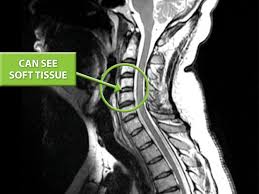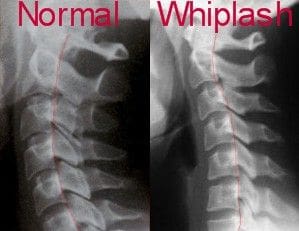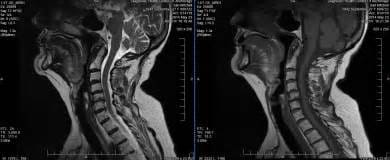In the United States alone, more than 2 million people suffer from whiplash injuries each year. Whiplash is the name given to a group of symptoms that occur when the neck jolts following an injury or an accident. Whiplash can happen with any impact or blow that causes the head to jerk forward or backward.
In a case of whiplash, the intervertebral joints (located between the vertebrae), discs, ligaments, cervical muscles, and nerve roots may become damaged. Injuries to the neck include strained muscles, ligaments and tendons, and herniated discs. This jerking motion strains the neck and the abrupt force can also injure bones in the spine, discs between the bones, ligaments, muscles, nerves, and tissues in the neck. Any time there is a fiber torn in a muscle or tendon, it’s called a strain. If this occurs in a ligament, it is called a sprain. Whiplash generally involves both a strain and sprain. Type and extent of injuries can vary greatly per individual.
Signs and Symptoms of Whiplash Injuries
Symptoms of whiplash usually manifest themselves within 24 hours of the accident, but typically show up within the first 6-12 hours. If left untreated, symptoms can worsen in the days following the injury. When symptoms occur, they often include:
- pain and stiffness in the front and back of the neck (the pain may get worse when turning the head)
- headaches
- pain in the shoulder or between the shoulder blades
- low back pain
- pain or numbness in the arm and/or hand
- a tingling sensation in the shoulders or arms
- jaw pain
- dizziness
- ringing in the ears
- blurred vision
- difficulty concentrating or remembering
- irritability
- sleep disturbances and fatigue
- depression
- memory loss
- trouble swallowing
- nausea
Symptoms related to whiplash can worsen through sustained postures like reading, driving, sitting in a computer, using a mobile phone, or watching TV.
Most people who undergo whiplash can recover within a few months. Some people are impacted by the injury for many months or even years after the initial episode. Its essential to seek medical attention for a whiplash injury to help speed up the healing process and reduce pain and swelling as soon as possible. Studies reveal that the someone and a physician visit the shorter their recovery time.
Diagnosis and Treatment for Whiplash Injuries
Generally, whiplash can be diagnosed clinically by a thorough history and physical examination by a healthcare professional. In most cases of whiplash, injuries are to soft tissues such as discs, muscles, and ligaments, and cannot be observed on X-rays. Specialized imaging tests, such as CT scans or magnetic resonance imaging (MRI), may be needed to accurately diagnose whiplash, but are not required for the diagnosis.



Previously, whiplash injuries were often treated with immobilization (preventing the neck from moving) in a cervical collar. However, the treatment is to encourage movement rather than immobilization.
Ice may be applied for the first 24 hours after the injury, followed by gentle active movement. Common treatments for whiplash include:
Chiropractic Adjustments: Spinal adjustments done by a doctor of chiropractic will help restore normal joint movement and function on your neck. Your whiplash pain can be treated by a chiropractor at its source, by treating the subluxations in your spine. This restore function to your nerves allowing your body to recuperate faster and will reduce your recovery period. Chiropractic adjustments can decrease your pain levels and help you feel better faster.
Massage: In combination with chiropractic care, massage can be a beneficial treatment for whiplash injuries. A massage by a therapist can help relieve discomfort and pain associated with whiplash. There are 3 kinds of massage are usually used for whiplash treatment. The first sort of massage is called myofascial release. Myofascial release techniques help loosen limited neck muscles and fascia to improve. The second sort of massage is known as static compression. Implementing static compression to the trigger factors increases oxygen flow to the impacted muscles. This increased flow of oxygen helps muscles heal. The third type of massage is called deep tissue massage. Deep tissue massage helps release deep fascia, adhesions, and scar tissue which may occur with a whiplash injury. This sort of massage can help back and free up tissue that has tightened around nerves in the neck. Make sure to tell the massage therapist your pain level before receiving any sort of treatment.
Exercise: A chiropractor, in addition to other healthcare professionals, can recommend a variety of stretches and exercises, aside the primary therapy, to help improve the symptoms of whiplash. An acceptable set of physical exercises can help the overall recovery of the individual, speeding up.
The scope of our information is limited to chiropractic and spinal injuries and conditions. To discuss options on the subject matter, please feel free to ask Dr. Jimenez or contact us at 915-850-0900 . 
By Dr. Alex Jimenez
Additional Topics: Automobile Accident Injuries
Whiplash, among other automobile accident injuries, are frequently reported by victims of an auto collision, regardless of the severity and grade of the accident. The sheer force of an impact can cause damage or injury to the cervical spine, as well as to the rest of the spine. Whiplash is generally the result of an abrupt, back-and-forth jolt of the head and neck in any direction. Fortunately, a variety of treatments are available to treat automobile accident injuries.

TRENDING TOPIC: EXTRA EXTRA: New PUSH 24/7®? Fitness Center
Post Disclaimer *
Professional Scope of Practice *
The information herein on "Understanding the Signs and Symptoms of Whiplash Injuries" is not intended to replace a one-on-one relationship with a qualified health care professional or licensed physician and is not medical advice. We encourage you to make healthcare decisions based on your research and partnership with a qualified healthcare professional.
Blog Information & Scope Discussions
Welcome to El Paso's Premier Wellness and Injury Care Clinic & wellness blog, where Dr. Alex Jimenez, DC, FNP-C, a board-certified Family Practice Nurse Practitioner (FNP-C) and Chiropractor (DC), presents insights on how our team is dedicated to holistic healing and personalized care. Our practice aligns with evidence-based treatment protocols inspired by integrative medicine principles, similar to those found on dralexjimenez.com, focusing on restoring health naturally for patients of all ages.
Our areas of chiropractic practice include Wellness & Nutrition, Chronic Pain, Personal Injury, Auto Accident Care, Work Injuries, Back Injury, Low Back Pain, Neck Pain, Migraine Headaches, Sports Injuries, Severe Sciatica, Scoliosis, Complex Herniated Discs, Fibromyalgia, Chronic Pain, Complex Injuries, Stress Management, Functional Medicine Treatments, and in-scope care protocols.
Our information scope is limited to chiropractic, musculoskeletal, physical medicine, wellness, contributing etiological viscerosomatic disturbances within clinical presentations, associated somato-visceral reflex clinical dynamics, subluxation complexes, sensitive health issues, and functional medicine articles, topics, and discussions.
We provide and present clinical collaboration with specialists from various disciplines. Each specialist is governed by their professional scope of practice and their jurisdiction of licensure. We use functional health & wellness protocols to treat and support care for the injuries or disorders of the musculoskeletal system.
Our videos, posts, topics, subjects, and insights cover clinical matters and issues that relate to and directly or indirectly support our clinical scope of practice.*
Our office has made a reasonable effort to provide supportive citations and has identified relevant research studies that support our posts. We provide copies of supporting research studies available to regulatory boards and the public upon request.
We understand that we cover matters that require an additional explanation of how they may assist in a particular care plan or treatment protocol; therefore, to discuss the subject matter above further, please feel free to ask Dr. Alex Jimenez, DC, APRN, FNP-BC, or contact us at 915-850-0900.
We are here to help you and your family.
Blessings
Dr. Alex Jimenez DC, MSACP, APRN, FNP-BC*, CCST, IFMCP, CFMP, ATN
email: coach@elpasofunctionalmedicine.com
Licensed as a Doctor of Chiropractic (DC) in Texas & New Mexico*
Texas DC License # TX5807
New Mexico DC License # NM-DC2182
Licensed as a Registered Nurse (RN*) in Texas & Multistate
Texas RN License # 1191402
ANCC FNP-BC: Board Certified Nurse Practitioner*
Compact Status: Multi-State License: Authorized to Practice in 40 States*
Graduate with Honors: ICHS: MSN-FNP (Family Nurse Practitioner Program)
Degree Granted. Master's in Family Practice MSN Diploma (Cum Laude)
Dr. Alex Jimenez, DC, APRN, FNP-BC*, CFMP, IFMCP, ATN, CCST
My Digital Business Card



